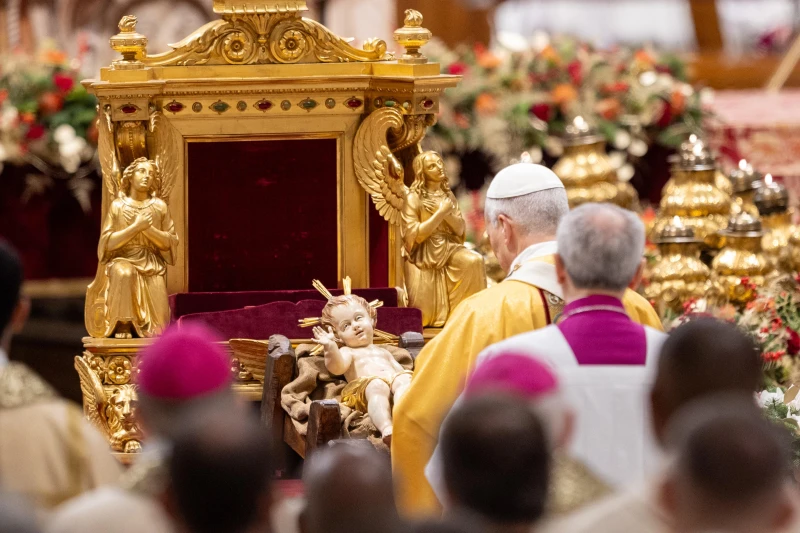The interior of the Cathedral Basilica of St. Louis, in Missouri. / Credit: Jonah McKeown/CNA
St. Louis, Mo., Dec 13, 2023 / 14:39 pm (CNA).
Pastors at each of the 25 Catholic elementary schools in the Archdiocese of St. Louis eyed for closure earlier this year have recommended that their schools remain open, the archdiocese announced Tuesday afternoon.
This news comes after the archdiocese announced in September that “some Catholic parish elementary schools may be recommended by the parishes to close” amid a yearslong major pastoral planning initiative in the archdiocese, “All Things New,” that has seen roughly 25% of the archdiocese’s parishes close or merge.
Some Catholics have expressed concern and frustration ever since Archbishop Mitchell Rozanski announced his final restructuring plans in May, objecting to the shakeup of parishes amid the many closures and priest reassignments.
The pastors overseeing roughly one-third of all the Catholic parish elementary schools in the archdiocese had consultative meetings throughout October with representatives from the Office of Catholic Education and Formation and their Episcopal Vicar. The meetings were focused on “the long-term sustainability of their parish elementary schools,” the archdiocese previously announced.
On Tuesday, the archdiocese said that all of the pastors recommended keeping their schools open for the 2024-25 school year.
“The pastors have now been asked, in consultation with the parish’s school board, finance council, parish council, and community, to create a feasibility plan that outlines how the parish will ensure the school’s long-term viability,” the archdiocese said.
The archdiocese said the plans should detail specific goals and actions that will be taken for the next three school years regarding projected enrollment; school costs for faculty, staff, programs, and supplies; realistic and sustainable funding sources; building condition and capacity; staffing; and other considerations.
Parishes will also be asked to consider whether their continued financial investment in the school will leave them unable to financially support other current or future parish ministries.
The feasibility plans are due to the archdiocese Feb. 1, 2024. After the plans are submitted, Archbishop Mitchell Rozanski may suggest revisions or amendments and encourage schools close to each other to consider how the other’s plan impacts their own, the archdiocese continued. Parishes may reconsider their decision to keep their school open, with the pastor making the final decision.
Though not one of the country’s largest dioceses, St. Louis has historically had a disproportionate number of students in its Catholic schools. As recently as last year, 38% of St. Louis’ Catholic elementary-school-age children were in a Catholic school compared with 13% nationally, and 31% of St. Louis Catholic high-school-age children were in a Catholic school compared with 10% nationally.
However, existing Catholic school building structures in the archdiocese are at only 65% capacity, the archdiocese said. There are overall fewer than half as many students — 19,000 — in kindergarten through eighth grade across the archdiocese as there were in 2000, the St. Louis Post-Dispatch reported.
Three Catholic schools in the archdiocese closed earlier this year — St. Rose Philippine Duchesne in Florissant, St. Mark in south St. Louis County, and Good Shepherd in Hillsboro. Also closed was Barat Academy, an independent Catholic high school in Chesterfield, the St. Louis Post-Dispatch reported.
Closures for two other high schools — Rosati-Kain for girls and St. Mary’s for boys — were announced, but supporters raised enough money to keep the schools open independently.
Overall, in 2021, the number of Catholics in the Archdiocese of St. Louis dipped below 500,000 for the first time since the 1960s. The number of parishes would have likely exceeded the number of priests by 2026 without action, according to archdiocesan projections.
“All Things New” is administered by the Pennsylvania-based Catholic Leadership Institute (CLI) and is very similar to pastoral planning initiatives undertaken by CLI in recent years in other major midwestern archdioceses, such as Pittsburgh and Cincinnati.
Before making the changes, the archdiocese held 350 listening sessions, with at least one in each of the parishes as they were at the time. It considered feedback from 70,000 Catholics in the archdiocese who participated in a survey.
Feedback was also solicited from 18,000 school parents, staff, teachers, donors, and community partners. In addition, the archdiocese held focus groups and talked with civil and business leaders. Rozanski said the feedback helped structure the final plan.











